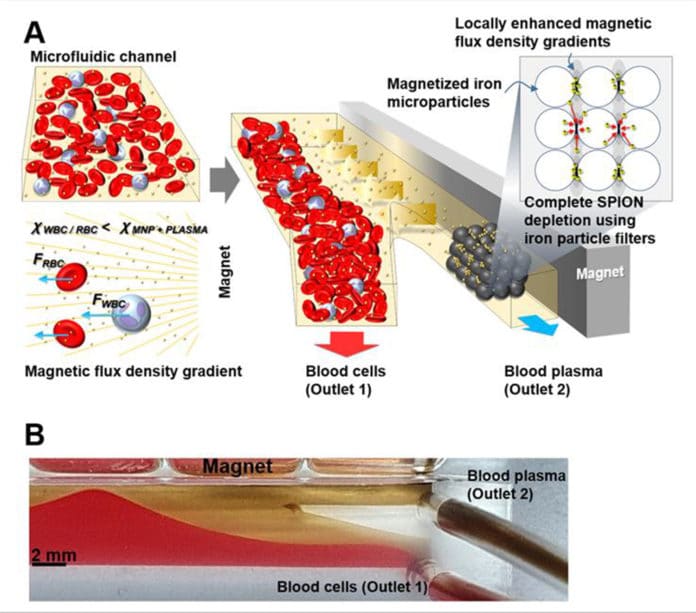Scientists from UNIST have come up with a novel technology for plasma separation from blood. This new plasma separation technology could significantly enhance the accuracy of point-of-care blood tests, which has shown the increased demand recently.
Using diamagnetic repulsion of blood cells, scientists were able to separate blood cells and blood plasma. In this method, the superparamagnetic iron oxide nanoparticles (SPIONs) are supplemented to whole blood. Once supplemented, the SPIONs turn the blood plasma into a paramagnetic condition, repelling all blood cells by magnets.
Using the technology, scientists were able to collect hemolysis-free plasma without losing plasma proteins, platelets, and exosomes.
Professor Joo H. Kang said, “Many efforts have been made to develop various blood plasma separation methods. However, there always have been limitations, such as dilution of blood, blood cell impurity in plasma, and hemolysis. Our approach overcame these unmet challenges, and we could provide a huge impact on in vitro diagnosis once this platform is translated into a commercial point-of-care device.”
Interestingly, the technology achieved 100% of the plasma purity and 83.3% of the plasma volume recovery rate. Moreover, it enabled the greater recovery of bacterial DNA from the infected blood than centrifugation and immunoassays in whole blood without prior plasma separation.
Research Professor Seyong Kwon in the Department of Biomedical Engineering at UNIST said, “We have overcome the limitations of a filter-based blood plasma separation method that potentially could induce hemolysis or a microfluidic chip-based plasma separation method that has the problems in a plasma recovery rate and purity.”
The essential characteristic of this new method is it allows to the collection of platelet-rich plasma (PRP). This acts as a significant feature as recent studies suggest that platelets could be used as a biomarker to diagnose cancer or diabetes.
Jieung Oh, the first co-author of the study, said, “Unlike a complex process of the conventional centrifugation method to collect PRP, our method can simply collect PRP by just tuning flow rates.”
Journal Reference:
- Seyong Kwon, Jieung Oh, Min Seok Lee, “Enhanced Diamagnetic Repulsion of Blood Cells Enables Versatile Plasma Separation for Biomarker Analysis in Blood,” Small, (2021). DOI: 10.1002/smll.202100797
